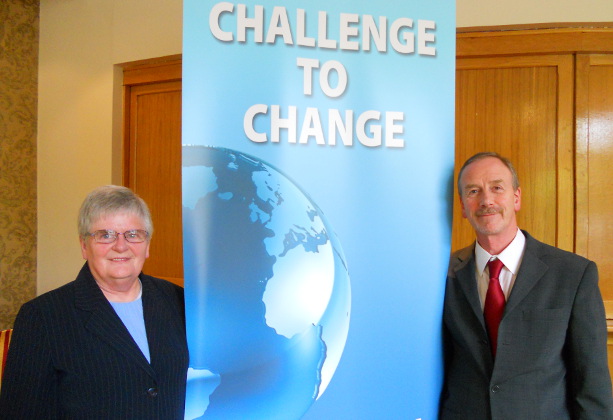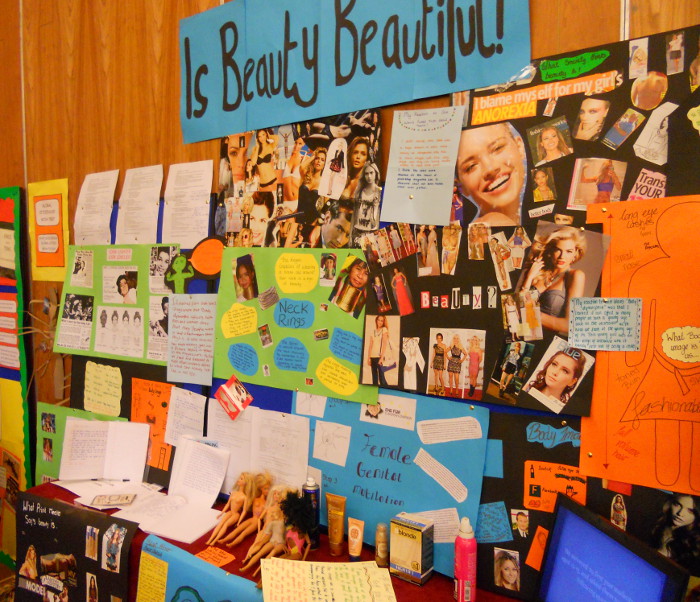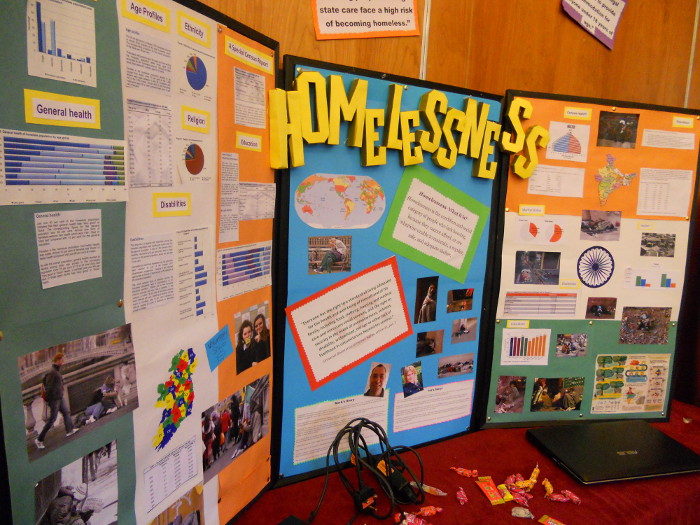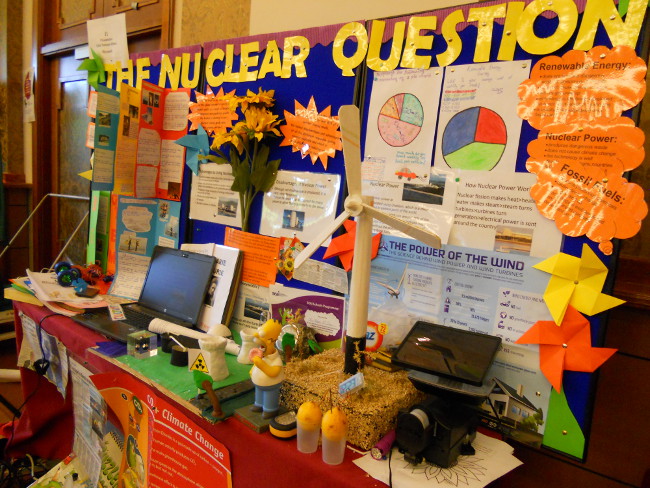
This marks the eleventh year of the Challenge to Change (C2C) network – a development education initiative in the Presentation Schools network. Tony Daly caught up with Margaret and Liam to chat about the project and reflect on how far the project has travelled in ten years and see what might be in store for the future.
Along with Evelyn Byrne, Liam Kilbride and Margaret Mary Healy, based in Warrenmount, Dublin, typically spend their days zipping around the country from Mitchelstown to Mullingar, from Portarlington to Kilkenny, from Clondalkin to Dungarvan. With 38 schools taking part in this year’s project alone, they have their work cut out for them.
School projects rarely have a recorded history stretching back over ten years and maintained on an annual basis. DevelopmentEducation.ie is proud to support Challenge to Change in launching the back catalogue of annual reports and make them available for the first time online.
_________________________________________
How did Challenge to Change come about?
MMH: We had been doing another project with schools around interculturalism and this was a development out of that. Ten years ago we invited all of the Presentation schools in the south east of Ireland to participate in a development education project called Challenge to Change and six responded. So, it grew from there.
LK: It grew out of a firm belief in young people in their enthusiasm, their goodwill and in the innate goodness of young people. We said, ‘let’s harness that’, when at that time young people were generally getting such bad press in the media. That was part of it too.
Six schools…humble origins!
MMH: Absolutely! But we were delighted to get six to start with as we weren’t sure how many schools would respond.
LK: It was based on Presentation values as well and the ethos behind it – justice, human rights, sustainability, care of the earth – all of those things. We wanted to have those in the Challenge to Change project because we felt it was important that all of those values become embedded in our schools.
So the values base was already being explored in schools educationally but you wanted to bring it together and support teachers in a broader national support system..
MMH: Each of the schools had their own mission statement and each of the values was embedded in it as Presentation Schools but I suppose C2C gave teachers and pupils an opportunity to do something practical and action-based about the values and bring them to life in a different way.
So what’s the project about?
LK: It’s about informing the students, bringing about a heightened awareness of global issues, of trying to foster a critical mind set and a social conscience. All of those pieces are what drove us – and continue to drive us as those pieces there are non-negotiable.
MMH: The project enables teachers and pupils to work in a cross curricular and whole-school way so you can have students as young as four years of age up to 18 years of age involved in a project. We are also adamant that the project is non-competitive and is a mix of primary and secondary so it crosses lots of boundaries and involves all students.

Most projects rarely factor in that kind of consistency in programming that is about the stages of growth and development of young people right through beyond say, a single year, and into a whole-education approach from start to finish as part of formal education.
The C2C project has been hugely successful. Why is that the case?
LK: It’s been very democratic. It has involved teachers, students, the whole school community in a whole-school way. This gives great ownership of the project. Another reason has been the relationship-building – linking with principals, linking with ‘champion teachers’, with enthusiastic coordinators, with students working at their ‘own pitch’, at their own level. As Margaret said, it’s not competitive. It’s something students share and it becomes deeper learning rather than cosmetic. In that way students can internalise what they have learned and reflect on it. The reflection piece has been one of the successes: to think about ‘what happened for me’ in a very honest and ordinary way.
MMH: We’re not prescriptive on what the project theme should be. As long as it reflects one of the broad issues of human rights, justice, sustainability, interculturalism then schools are free to choose a project that suits them at a particular time or that’s appropriate to a particular age group. So we might find that some schools feel that looking at child labour is more suited to older students at primary level rather than the junior end. So schools can choose, rather than us having to impose a particular topic. There are plenty to choose from in the development education sector. It gives that freedom to teachers and to pupils.
So much has changed over the last ten years from topics to select from that teachers and students can work on…
MMH: Yes, and also starting at primary level with development education means that it can be something that grows with them and they can carry into secondary education.
LK: To bring about the local-global connection that students can initially look at a global issue and they might say that it’s much too big to handle. To appreciate that something at local level can have a global impact is so important. It might be something as simple as a consumer choice: buying a fairtrade item or thinking about the sustainable way that they use energy or water. It can be a modest act but it helps to develop an appreciation that ‘I can make a difference’ locally.
MMH: It’s important too that the activities that students engage in are activity-based and there is learning through activity rather than just Googling information and copying it down. Students will remember what they get involved in and what they model on the classroom. Students are also encouraged to prepare a simple lesson on whatever topic they are studying and to possibly deliver that to junior or senior classes. We had a primary school delivering their project to a secondary school – and they weren’t daunted by the prospect either!
What are the benefits of being involved in Challenge to Change projects?
MMH: standing up and presenting in front of audiences, whether it’s your own class, school or indeed the end of year seminar and talking about what you have learned and what you have done gives students great confidence and a sense of responsibility. They are part of a team too, rather than doing projects in isolation.
LK: It’s not an academic exercise. We try to encourage teachers to employ a wide range of strategies and methodologies. It’s about engagement and harnessing all of the abilities of the students. We’ve had students who may have looked upon themselves as failures and will have blossomed by the end of the year because of the part they may have had in a C2C project because they were good at art, science or may have been good at role play or drama, and this is something that is harnessed by them and picked up by the students. Students do get the ‘critical mindset’ we so often talk about. We know that students, as they have progressed from primary into secondary have become leaders in the development education side of things in their new school and this is great for us. It will turn up again under a different guise for us three years from now in a different school and this is great!

Education initiatives always gives rise to that difficult and tenacious question about impact. What are the long term benefits in being involved in a programme like C2C? Has anything surprised you? Is it too soon to tell?
MMH: It’s difficult for us to track students once they change schools. Even after finishing formal education it’s difficult for schools to keep track of past pupils too to say exactly where students have ended up. We would rely on schools to let us know.
LK: We use questionnaires at the beginning and end of the project year to chart the change of awareness and mindset of students. That has been useful for us. At the end of year seminar we use monitoring and evaluation (M&E) to gather as much information as possible at that stage too. From ongoing evaluation we get a sense that students and teachers are changing over the course of a year and that’s super for us!
We try and get as many teachers and staff as possible in individual schools to work together on strategies that they wouldn’t have tried before. As part of a CPD course that we ran last year we trained the whole staff body within schools and we gave them ideas on how they can engage young people using DE.
MMH: Over the years we have seen different teachers at a particular school taking on the role of coordinator rather than just the first person who took it up which is good to know that it is being shared. Also we encourage the setting up of a steering committee in schools which involves students as well and gives them a role in deciding what they are going to do next, how they are going to do it, who are they going to talk to, how are they going to involve the parents themselves etc., and what speakers they might want, what NGOs they might want at the school. It gives responsibility and authority to the students as well as a greater feeling of involvement and ownership of the project.
It’s also good to see schools still with us after ten years so I suppose that’s a measure of interest and success as well. These schools look at the C2C project as inbuilt into their education cycles and timetabling for it. Some of our schools timetable specifically for C2C as a TY module so that’s great too!
C2C started out with six schools, as you’ve mentioned Margaret and it sounds like ‘modest beginnings’ but it’s a lot to manage! In thinking about the C2C education revolution over the last ten years do you know how many people have been a part of the journey?
MMH: That’s a challenge! If you take the schools, the pupils, the parents and local community it adds up to quite a number of people.
LK: We’ve calculated that roughly 14,000 people would be touched by the by the programme each year in one way or another, considering that this year we have 38 schools involved, which is kind of awesome. Consider multiplying that down the line over ten years and you get a sizeable number of people involved, even though we’ve been growing each year.
We’ve also had teachers acting as peer mentors for other teachers which has been very useful. We’ve had cluster meetings where teachers would share their resources, sharing strategies that have worked for them, exchanging phone numbers and email addresses and I think that’s great as they are not competing with each other.
That’s been a difficulty in designing DE initiatives where the use of competitions can give students an incentive and something to work towards as it can pit people against one another and may be part of the dynamics of working out DE in practice.
MMH: The end of year event where representatives from schools meet and talk about their project, share experiences and get involved in workshops is also good for the teachers as they can get involved in talking to pupils from others schools, chatting to other teachers and think of ideas for next year’s project.
‘Networking’ is a word that’s usually preserved for the business sector. For schools and teachers to be doing this is incredibly important and not be in competition so they can share, learn from and help each other. That’s a huge benefit to the network as it encourages networking and not just within schools alone.
LK: That we facilitate teachers to network, collaborate and share is something that is key to the sustainability to the project. New teachers can come on board and be enthused by other teachers. Sometimes a ‘champion teacher’ isn’t always great because they can disempower other teachers. One teacher doesn’t own the project. They should include all of the school and other students too.
MMH: The end of year network event gives students and teachers something to look forward to and a sense of being a part of something bigger rather than ‘my school in isolation’ and they get to see what other schools are doing and they also get a sense of the wider Presentation network and learn from the other students in other schools. The primary school students engage affably with the secondary school students – there is no competition between them either! They are very much part of one family.

Are there any C2C highlights from over the years that jump out?
MMH: At our first end of year seminar a decade ago students were competing for a space to be heard. Subsequently we added in workshops and certainly learned along the way how to do it (and how not to do it!). The participation of students and teachers in the workshops added an extra dimension to it that we’ve used ever since.
LK: A very simple thing happened where one of the post primary schools invited a group of primary students to carry buckets of water around the hotel where the annual event was taking place so that they could simulate what it was like – especially for girls – in developing countries to carry water every day and this was their journey. Those students will never forget that. Their arms, so tired from carrying buckets of water – a simulation innovated by students, was a powerful experience. Learning by doing!
MMH: We also had students from a small rural primary school having no inhibitions about going to a secondary school and teaching them what they had learned about child soldiers and slavery and engaging with them. Over the years the methodologies developed by the students and teachers have adapted, such as the use of technology, film clips, animations and blogs for education. That wasn’t there ten years ago. It was very much ‘there: put all the information up on the display board’. Students are now quite au fait with blogs, Powerpoints and very happy to plug in their laptops and show videos of what they have been working on all year.
Challenge to Change has ten years under its belt. What do the next ten years have in store for the project?
MMH: We hope that the network will grow and involve more students, and that it will impact more effectively. We’ve been linking Presentation Schools abroad with local schools and this has been a challenge given the political climate in some of the countries that they are based and the lack of internet access, for example. But schools manage and there are ways to communicate with them. We’re hoping that this will develop more as we have had to live within these kinds of constraints.
LK: We would like the C2C brand to become synonymous with DE in schools, particularly deep learning in schools. As the project expands we would hold fast to the vision statement and values that we would consider as being non-negotiable – that there’s depth to it, that there must be sharing, that it must be democratic in every way.
It’s a remarkable position to be in to see that the visions set out previously have held fast and that they do work, ten years later since adopting them and that they have been sustainable and continue to be.
LK: It must be dynamic. It [the values] cannot paralyse the growth or the development of the project either. They are there in the background but that doesn’t preclude you from being more creative, adopting new technologies or advancing local developments with global issues as they come up.
MMH: The global challenges we face each year change over time. While the underlying problems might be similar there are plenty of challenges for us in the world to last us ten more years!
Thanks Margaret and Liam for speaking to us today and we’re very happy to support the Challenge to Change project and annual resources that have been produced for people to look at, make use of, share, learn from and design their own DE materials.
